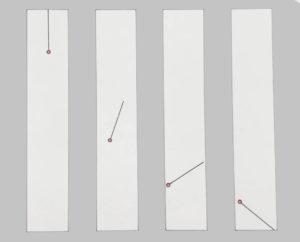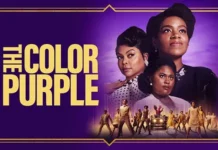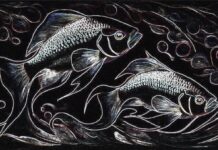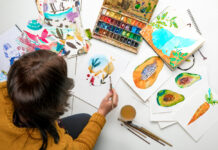As the daughter of an artist, I grew up understanding that art heals, that creative expression is one of the most profound ways human beings have coped with collective and individual hardships throughout our history. Its origins reach back many thousands of years. As a kid, I would pore over books about cave paintings and shaman artists. Seeing myself in those caves, I understood that the practice of art-making represented something at the very core of how humans make sense of their world, grieve, worship, and create change within their communities.
To me, in modern times, art’s most important role is this: to help lift the forces of psychological oppression from one’s heart and mind. Within my life as a psychiatric survivor, art has served me in this way. Its power to heal trauma was the strength underlying my ability to shake the psychiatric industry from my life. Through art-making, I could let my mind exist as it was and honor it without the label of disease. I pressed my art and writing into the world, put aside what I was told was “crazy”, and instead saw my imagination, my trauma, my grief, and my creativity as something profoundly beautiful, and even more importantly, something worthy of having a voice. Art was my path to empowerment.
Artists are often indifferent to norms those in power attempt to coerce us to accept and internalize. These norms are so often in opposition to our authentic selves. Sometimes artists are forceful in throwing off ideas and strategies of control, as we see in times of cultural and political revolution. Artists can serve as society’s radical conscience, holding up a mirror in which we as a people can see ourselves and question our collective choices. My art is how I question the world, the one external to me and the one internal to me. It is how I explore and push the boundaries of my perceptions.
Art moves us, individually and collectively. It moves ideas and truths inside us out into the world. It moves feelings within us and transforms them. I truly believe it moves the energy of trauma in our body that has become frozen or stuck. Suffering itself can be moved toward healing within the practice of creating. Art is a vehicle through which our inner world can become an imaginative dialogue, rich with possibility and new ideas, new feelings and growth. It can become a dialogue external to us as well, as our courage in expression moves those that witness it to explore and express themselves.
Art is also love, a kind of gift. In a support group for those in psychiatric drug withdrawal, I recently said that despite all the horrors psychiatric survivors endure, we are positioned to love ourselves so deeply and radically, if just in a reactionary way against the forces encouraging us to constantly judge and restrain ourselves. It is this self-love that is the core of my creating. It is a constant process of seeing, loving, and offering. It is a constant challenge to love myself more deeply and to accept every bit of who I am, how I see, what I feel.
#Transform Your Trauma
To me, the power of art to transform our lives is undeniable. To me, art is a societal force that moves us forward, just as important as technology and science.
I’ve been using the hashtag #TransformYourTrauma on Instagram since I started sharing my artwork early last year. This phrase is the essence of what art has been for me throughout my life. The act of creating art is a process of transformation. To me, it is not about the product, but the process. It doesn’t have to be good, or skillful, or profound. The key is in the doing, the act of making. When you embrace the possibilities of your imagination, when you free yourself to express without censorship, without self-judgment or the judgment of others, you nurture the ground of emotional healing. The practice of art-making can be a safe container for this profound exploration.
I truly believe art-making is one way we will emerge a better people, and I invite you to share your artwork in the spirit of art’s healing potential with the hashtag #TransformYourTruama on social media, to be included in a stream of artwork.
The Exhibit
The pandemic lockdown last year afforded me a precious gift of time to explore my creative spirit, and that, in turn, gave me a powerful way to cope with the constant fear and upheaval surrounding me. I set up a drafting table and drew most days for hours on end – responding to how the pandemic had impacted my life, the sensations of psychiatric drug withdrawal, my experience as a survivor of psychiatry, the financial insecurity, isolation, and political tension surrounding me. I reconnected with myself in so many ways and it was, for me, so healing.

My lived experiences with psychiatry and mental distress, which are so common among artists, became the fuel for engaging with the movement to reform psychiatry and became a new purpose for my art as well. After writing a few pieces for Mad in America about my experiences, I began working for them managing their social media. My career before COVID was in doing this for arts organizations. It was always my mission throughout my adult life to serve artists in whatever way I could.
I quickly found that the Mad in America community strongly valued the arts as well. After conversations with Robert Whitaker and others at Mad in America about how they saw the role of art in recovery, I knew there was a valuable opportunity in creating an online art exhibit. Speaking with Staff Reporter Amy Biancolli and reading her series of articles on the power of music galvanized me further to offer a call for art to our community of those with lived experience of mental distress and psychiatry.
It is an exciting opportunity to offer this exhibit and the open call to artists to share how they have engaged with art over the past year, how perhaps it has been healing for them in the face of this global pandemic. I share “Creativity and COVID: Art-Making During the Pandemic” in the spirit of connection and community during a time of both collective suffering and hope for healing. I hope to forward the understanding of creative expression as one profound way to promote emotional healing and recovery, whether it be from individual hardships, those of a nation, or even those of the entire globe.
Please click here to visit this online exhibition.















“To me, in modern times, art’s most important role is this: to help lift the forces of psychological oppression from one’s heart and mind.”
I agree. But, artists should be forewarned, since we may be systemically targeted and attacked by “mental health” workers, as I was.
“Through art-making, I could let my mind exist as it was and honor it without the label of disease. I pressed my art and writing into the world, put aside what I was told was “crazy”, and instead saw my imagination, my trauma, my grief, and my creativity as something profoundly beautiful, and even more importantly, something worthy of having a voice. Art was my path to empowerment.”
“A picture paints a thousand words.” I was attacked as a young artist, just starting out working on my portfolio. Now my art is so “too truthful,” and “maybe the world is ready for a ‘Chicago Chagall’,” that a second ELCA psychologist – who actually looked at my work – attempted to steal all profits from my work, my story, and his hope was to eventually steal all my money and work, according to the “art manager” contract he handed me. Of course, I said go away. Although, I’ve run into many “mental health” workers who don’t seem capable of understanding English, let alone the concept of ‘live and let live.’
“Artists can serve as society’s radical conscience, holding up a mirror in which we as a people can see ourselves and question our collective choices.”
And, hopefully, our work will function as a truthful recording of history. But in this time of ‘universal deceit,’ most definitely, my work is considered ‘radical.’ Especially to those psychologists who want to “maintain the status quo,” and “get all the money in the hands of a small number of banking families.”
“Art is also love, a kind of gift.” Absolutely.
“It is this self-love that is the core of my creating.”
Yes, psychiatry’s and psychology’s incessant desire to defame, neurotoxic poison, steal from, and to try to control artists, is about hate, or jealousy, or greed, or some other negative human trait. And my work is about a love of God, others, truth, and of self. So I cannot allow my art to be controlled – whatsoever – by the exceedingly negative, DSM deluded, people.
“To me, the power of art to transform our lives is undeniable. To me, art is a societal force that moves us forward, just as important as technology and science.”
I agree, and hope you are right. I know, once I’d explained one of my recent pieces of art to someone, it made him actually cry. Ironically, the piece is called ‘Tears of Both Joy and Sorrow.’ Art should describe the human experience, which – obviously to all, except certain “mental health” workers – includes tears of both joy and sorrow. They believe all who have either tears of joy or sorrow are “bipolar.”
“The key is in the doing, the act of making. When you embrace the possibilities of your imagination, when you free yourself to express without censorship, without self-judgment or the judgment of others, you nurture the ground of emotional healing.”
Yes, and it is the “too truthful” artwork of us honest artists, of which the “mental health” system are most afraid. And a “bad guy, dah” / psychologist, within a mainstream religion, wanted to “manage” / control. Psychologists should stop attempting to “manage” and/or control the artists.
I’ve been working on a lot of family business this year, we got a lot accomplished, thankfully. But I did not get a lot of artwork done this year, unfortunately. Plus, I’m still trying to catch up on the telling of my story, with my artwork. I’m working on a couple pieces right now about a day in 2009 (during my last drug withdrawal induced ‘super sensitivity manic’ healing period) – a pointillism Federal Reserve piece, and a Chagall inspired Michigan Avenue bridge piece. Long story.
I do plan to do a pointillism ‘Corona World’ piece soon. But each pointillism piece takes a LOT of time. But they are pretty cool, once they’re done. And, since the artists are forced to research medicine, to find the medical proof of how the psychological and psychiatric systems made us sick.
https://www.alternet.org/2010/04/are_prozac_and_other_psychiatric_drugs_causing_the_astonishing_rise_of_mental_illness_in_america/
https://en.wikipedia.org/wiki/Toxidrome
https://en.wikipedia.org/wiki/Neuroleptic-induced_deficit_syndrome
And since too many of the mainstream doctors aren’t being honest with their patients, due to their greed. That does leave us artists playing catch up, in regards to our own work. Not to mention, I can’t afford to get my work properly photo documented every year.
I wish I could submit something from this past year, but I likely can’t. And one piece I finished in 2020, which is really cool, is a documentation of history, not about the Corona virus insanity. Nor “prophetic,” as that psychologist, who wanted to take control of all my work, believed my work to be. Maybe I can get that “Tears of Both Joy and Sadness” piece photo documented, and submit it? Oops, no, I signed it this year, with a guesstimated 2019 completion date.
I’m pretty certain we, societally, have a problem with the “awakened” / “canary in the coal mine” artists vs. the pharmaceutical industry deluded “mental health” industry, who can’t stand to be awakened to their systemic crimes against humanity.
But since they’re killing “8 million” innocent people every year, I do so hope the “mental health” industry will wake up soon. And I do have another recently finished, Chagall inspired, piece about the need for society to Wake Up, that I call “Cock-a-Doodle-Do.”
https://www.nimh.nih.gov/about/directors/thomas-insel/blog/2015/mortality-and-mental-disorders.shtml
I understand confessing to the “mental health” industry’s systemic murders of millions every year, would be difficult to do, but they should. Since they’re also raping our entire economy for their malpractice insurance, but not utilizing it for what it is intended.
Perhaps, only including the systemic Corona virus 2020 crimes against humanity by doctors, in an art show by MiA, is a tad too limited?
Report comment
Your pointillism work sounds really cool! Shoot me an email maybe we can work something out. And thanks for your comments! Keep creating!
Report comment
Thanks Karin.
When you say reform, what is meant by this?
I have yet to see what reform means exactly. And would those who want reform then use the reformed product?
And would this reform be about the things that they themselves do not like?
Psychiatry is not science, nor is it an expression of art. It is an expression of hostility towards what is seen as weakness and faults, a hostility that we are all capable of.
Report comment
I guess I am quite shocked at the word “reform”, because it seems most people fail to go further in explaining what they mean by it, and the word just sits there.
So the reformists all present these “humane” ways that psychiatry can keep practicing and what exactly does it look like?
How to you reform a liar? A murderer? A hostile political institution? It is deeply insulting to people who have been abused to suggest to them that the abuser can be “reformed” and that the abused are safe to then venture into that reformed territory.
And so, for eons, we keep using the words “please be nicer” in your helpful domain. Because really, we are then taking part in saying that the mentals all need treatment by psychiatry, but we just want them to be “nicer”. A bit more “humane”. A bit better treatment for all those ADHD kids? What does it look like? Does it look like not calling them ADHD and not othering them? Does it mean smaller doses of the speed? Does it mean naming fewer kids so there are only some that get fried? Is it humane to damage fewer cretins? Only some should get tied up? Only some should get labels?
And with that, I would like to know how you marry artwork that says “burn down the house of psychiatry” with “reform”
Report comment
How to you reform a liar? A murderer? A hostile political institution?
People can reform themselves. Institutions sometimes can be reformed, but not institutions devoted to inhuman goals from the start. So your critiques are basically spot on. Also more loquacious than they have been recently. Mercury is leaving retrograde soon, maybe that’s it. 🙂
Report comment
Thank you Karin, for this piece. When I first got out of the psychiatric hospital (for the final time) a few years ago, I signed up for a creativity course with Robert Fritz here in Vermont. Instead of this class helping me recover from the years of traumatic experiences both in and out of the hospital, I was immediately scapegoated by this so-called teacher about the “creative process”…He singled me out for nasty commentary and scathing critiques so openly that he only traumatized me further. But one day, a comment he made released something in me. He said, you can’t use art to solve your problems.
My reaction was one of, Huh?! Then I wrote a blog post listing all the writers, musicians and artists who had done precisely that… and I stopped allowing Fritz’s comments to destroy me. Eventually I was refunded my money for this course and I moved on, but my depictions of what happened to me and what psychiatry did to me have most definitely been healing for me and others. In fact, exposing some of the in-hospital “treatments“ used so often to discipline and control patients has been liberating. Art not only heals, it can help us create a new world, free of psychiatry’s baleful influence.
Report comment
Pheobe, thanks for your comment. I’m glad you were able to move on from an art teacher who obviously did not understand its power. And your last sentence there is so true, much love and keep creating!
Report comment
MIA readers may be interested to read a blog from last fall about Phoebe’s artwork and its meaning. The piece also has stunning examples of her work.
https://www.madinamerica.com/2020/09/mirror-repeats-phoebe-sparrow-wagner/
Report comment
Thanks Miranda.
Report comment
Thanks so much Miranda! Such powerful work Phoebe!
Report comment
Hey Sam!
Well, you’ve read my other work on here, I approach it from a position of “reforming” (admittedly a word that could be interchanged with others like transform, etc) psychiatry by trying to move people through art and writing to change how we as individuals and a society relate to our own and each others suffering – changing minds through telling my story. I am just an artist and a writer, and that is just about all my work can do (not that this is a small thing!). And of course, the change is not always guaranteed. But, must try and do what I can.
Report comment
I don’t want to seem impertinent, but I feel I need to ask one question: is it still “psychiatry” if it is focused on moving people through art and writing to change how we relate to each other’s suffering? That doesn’t sound like a “reform.” It sounds like an utter repudiation of everything psychiatry currently represents. Sort of like transforming a cannon into a flower planter. It’s not really a cannon any longer, even if it’s the same shape.
Report comment
To be slightly nitpicky about your otherwise fine analogy, we don’t even need the shell of psyhciatry; flowers grow fine in natural earth. But I don’t think an analogy can be perfect, otherwise it would be an equation. Or something, It’s late. 🙂
Report comment
Well, let’s say you brought the canon onto your third-story balcony then, and filled it up with dirt and planted petunias. I’d say it could serve that purpose, though a standard planter might be more practical!
Report comment
I think we are wasting our time talking about reforming, or rethinking psychiatry. We need to reform the public, our politicians, our governing bodies. And art such as yours helps to do that. Books such as “Anatomy of an Epidemic” help to that.
Only the public can be caused to “think”. The ones who went for “training”, did so for a personal reason and are immersed in their own personal lives and gains. One cannot reform that.
Report comment
Psychiatry cannot be reformed, it must be abolished.
This is a basic “scientific” principle that has been repeatedly reaffirmed by the active AP movement at the time — in 1976, in 1982 and most recently in 2020.
Something based on fraudulent principles cannot be reformed. “Reform” can only apply to something that once had value but has since deteriorated.
Report comment
P.S. The positive things you mention have nothing to do with “transforming psychiatry”; they are just good things, period. Lets leave psychiatry out of the equation completely; it’s an interloper at best.
Report comment
The author here seems to have mostly found her way through art. However there are several myths about art and artists, the predominate one being the “artistic temperament.” Although, I am no “expert” I wonder if that myth may have grown out of the toxic chemicals first used to produce paints and related art-making products in the Middle Ages and Renaissance. Now, most of the paints are basically produced as “non-toxic” so they can even be used around children. The other related myths are that art results from traumatic experiences in life and that to be an artist, one must live an unconventional life, dressing and eating unconventionally, etc. These myths may actually be true for some individuals who like to “do art.” But, it is not true for everyone. Since, it is not true for everyone, it does make anyone who likes to “do art” vulnerable and suspect to the “psychiatric mafia.” These myths have personally caused me great consternation in my life. To do any kind of art, all one must be is to be true to oneself in one’s work, etc. That is all. It is good that “doing art” can help someone get through times of intense stress on a personal or greater level. However, stress can for some be adverse to any kinds of “doing art.” However, the main thing about art is that it can be very freeing, especially if done apart from therapy or not necessarily used as a therapeutic means. Personally, there are some kinds of “art doing” that truly help me organize, order and declutter my damaged brain from the psych drugs and therapizing I endured. But, I do not consider it therapy. I consider it my life. Thank you.
Report comment
Rebel,
Thanks for this comment. I agree with what you’re saying. I have met stereotypes and myths of artists with much suspicion my entire life – especially the poor, moody, and traumatized artist. Artists are just people with a different way of expressing themselves. I’m glad art serves you the way it does.
Report comment
Removed for moderation.
Report comment
I forget atm who called artists “the antennae of the race” — TS Eliot maybe? Anyway it’s pretty spot on.
Report comment
Removed for moderation.
Report comment